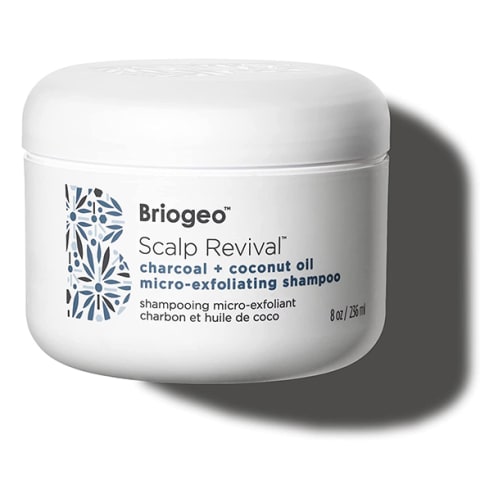
December 29, 2021 — 1:02 AM
Scalp pain or tension can be a strange sensation to identify. It’s not necessarily a headache or a wound but instead is more of an uncomfortable feeling that can itch, ache, tingle, or burn. Though the source of the pain may be something as obvious as heat from a hairdryer or tension from a too-tight ponytail, there are also all kinds of underlying factors that come into play such as stress or product buildup. Keep scrolling to learn more about where scalp tension may be coming from and how you can resolve it.
What causes scalp tension & pain?
There are a variety of conditions, environmental factors, and hairstyles that can cause different kinds of scalp tension and pain:
There are two types of buildup you can experience on your scalp: natural and product. Natural buildup is when natural gunk like dead skin, dirt, or sebum accumulates on the scalp. This typically happens if you go too long between washes. Then there’s product buildup, which is when hair care products like hair spray, dry shampoo, or other styling products build up on the scalp.
No matter what’s causing it, just buildup, in general, can lead to scalp inflammation. This can cause pain, itching, and overall discomfort.
A slicked-back ponytail or braided ‘do may look incredibly cool, but these styles may also be the reason for some scalp pain caused by tension. “Out of all the hairstyles, ponytail and braids cause the most scalp tension and pain,” hairstylist Devin Toth says.
Certified trichologist and founder of Advanced Trichology William Gaunitz further explains, “depending on how tight a ponytail or braids can be, it can produce inflammatory tugging that will result in scarring and traction alopecia as well as scalp pain and tenderness.” However, he points out that this reaction would only occur after “extraordinary tension over long periods of time” due to the disruption it would create in the hair cycle.
There’s no denying that stress can wreak havoc on your physical health, affecting everything from your skin to your gut. Now we can also add the scalp to that ever-growing list.
postbiotic body lotion
Ultra-hydrating formula that nourishes your skin barrier

Just like people clench their jaws or hunch their shoulders when they become stressed, there are also muscles in the scalp that can tense up during stressful times. The largest is the temporalis muscle, which runs from behind your ear, around your head, and to the back. When carrying stress, you may be tightening these muscles, which can cause a “stiff scalp.”
It’s easy to zone out when you’re styling your hair the same way every day. When this happens, you may notice the air from your blow dryer quickly warming a certain area of your scalp. Or perhaps you start to feel the heat from your curling rod making its way to your scalp. “Burning your scalp with a hot blow dryer or styling iron can definitely cause scalp pain,” Toth tells us. Luckily the solution is simple: “You don’t need to get that close to your scalp with hot tools.”
5. Inflammatory scalp & skin conditions
Beyond just buildup, there are other scalp and skin care conditions that can lead to painful inflammation. Gaunitz says some common conditions include seborrheic dermatitis, psoriasis, and dandruff. Both seborrheic dermatitis and psoriasis can cause scaly patches and red skin. Meanwhile, seborrheic dermatitis can also incite stubborn dandruff, which is skin on the scalp flaking off.
4 ways to ease scalp tension.
Once you’re able to identify where the scalp tension and pain is coming from, you’ll want to do your best to relieve it. The solution could be as easy as loosening your hairstyle or giving yourself a regular scalp massage. But if you’re struggling to identify the issue, you may need to seek professional help.
1. Loosen your hairstyle.
This may seem obvious, but it is quite necessary if a tight hairstyle is what’s causing your scalp tension. If you really need to provide a good bit of relief to your scalp, Gaunitz suggests wearing your hair down altogether. But if you do still want to wear your signature updo, Toth has a few tips and tricks to alleviate some of the pull.
If you’re pulling your hair back into a high pony, he suggests first gently backcombing your hair before brushing it back entirely. He also recommends using an elastic that relies on texture rather than tightness, such as the Spiral Hair Ties from Kitsch. (Find mbg’s other favorite breakage-free hair ties here.) “Another option is to leave the face-framing section of hair down and out of the ponytail, and gently pinning those sections of hair back with bobby pins,” he explains.
For braids, you’ll want to make sure you’re being careful with how tight you’re pulling while you’re styling. As board-certified dermatologist Raechele Cochran Gathers, M.D., once told us, “Beauty should never be painful.” For more tips on braid care, check out this guide.
2. Use a scalp scrub or exfoliating shampoo.
Just like your skin needs regular exfoliation, the skin on your scalp also benefits from this step. Enter: scalp scrubs. Scalp scrubs are a great way to break down and eliminate buildup, but before incorporating a scrub into your routine, it’s important to note that not all scalp scrubs are created equally.
While there are the physical exfoliant scalp scrubs that use sea salt or sugar mixed with essential oils, this may further irritate inflammation and cause even more pain. That’s where chemical exfoliants like tea tree oil and salicylic acid can come in handy. As an astringent, tea tree oil is a great ingredient to remove and prevent buildup with equally beneficial anti-inflammatory properties. As for salicylic acid, it’s a beta-hydroxy acid that removes excess oil and dead cells that can cause irritation, flaking, or dandruff.
3. Give yourself a scalp massage
If you think stress or tight hairstyles may have something to do with your scalp pain, giving yourself a regular scalp massage can help relieve this pain while also loosening built-up tension. “Massaging your scalp with coconut oil two to three times a week and washing it out after 45 minutes,” Gaunitz says, may help. The coconut oil will not only make it easier for fingers to move through your hair, but it also provides soothing and healing properties for the skin and moisture for both the skin and hair.
All you have to do is use the pads of your fingers to apply medium to hard pressure on your scalp and move around in circular motions. If you want to invest in tools for this, there are different scalp massagers that can be used regularly in the shower. Meanwhile, Gaunitz also recommends using a gua sha stone. (Here are the best gua sha stones on the market, if you’re interested.)
4. Seek professional assistance.
If the scalp pain and tension goes beyond a tight hairstyle or stress that can be relieved through a regular scalp massage, you may want to talk to a dermatologist, hairstylist, or other professional to get their expert assistance. This will become especially necessary if you’re dealing with skin or scalp conditions like seborrheic dermatitis and psoriasis.
There are a lot of reasons your scalp and hair might feel a bit tender—and many are not that big of an alarm. Just use it as a gentle reminder to pay attention to that precious and delicate skin on the top of your head.

postbiotic body lotion
Ultra-hydrating formula that nourishes your skin barrier
postbiotic body lotion
Ultra-hydrating formula that nourishes your skin barrier

https://www.mindbodygreen.com/articles/why-does-my-scalp-hurt








